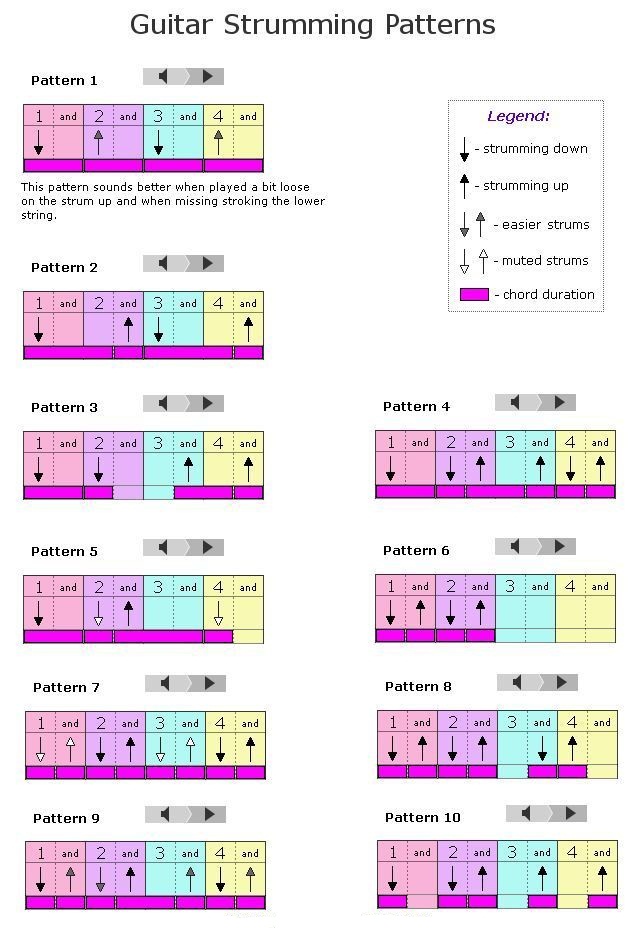Congratulations on picking up a guitar! You’re about to embark on a musical journey filled with fun, frustration (but hopefully mostly fun). One of the first things you’ll want to master is strumming. It’s the foundation for countless songs and styles, and the good news is there’s a super simple pattern to get you started.
The Essential Downward Strum
This pattern might seem basic, but it’s incredibly powerful. It involves exactly what it sounds like: strumming the strings down with your pick (or fingers, if you prefer fingerpicking). Here’s how to nail it:
- Posture: Sit or stand comfortably with the guitar cradled against your body.
- Pick Grip: Hold the pick between your thumb and index finger, using a relaxed grip.
- Strumming Motion: Move your picking hand up and down at a steady tempo, focusing on the wrist movement. Don’t tense up your arm!
- String Target: Aim to strum across the thicker strings (usually the bottom three) to create a full sound.
- Counting: Strum down on each beat of a 4/4 time signature (one, two, three, four). You can use a metronome or drum beat to keep time.
The Down-Down-Up-Down Strum: Your Gateway to Greatness
This fundamental pattern is all about alternating downstrums and upstrums with your pick. Here’s a breakdown, step-by-step:
- Down strum: Imagine you’re swatting a fly across the strings. Move your pick down across them, hitting all (or most) of them for a full sound.
- Down strum: Do another down strum for emphasis.
- Up strum: Think of flicking a coin with your pick. Catch fewer strings on this stroke, usually the higher three for a brighter sound.
- Down strum: And back to a powerful down strum to complete the cycle.
That’s it! The magic lies in the consistent, even rhythm. Count along as you strum: “Down, down, up, down…” Start slow and focus on a clean switch between up and down strokes.

Example in Action: Strumming Your Way to “Brown Eyed Girl”
Let’s put this essential pattern to work with a classic song – “Brown Eyed Girl” by Van Morrison. The song uses a simple variation of the down-down-up-down strum. Here’s how it breaks down:
- Chords: The song primarily uses three chords: G, D, and Em.
- Strumming: Strum the down-down-up-down pattern once per chord change.
Now you have the tools to play the basic rhythm of “Brown Eyed Girl”! Strum slowly at first, focusing on switching between down and up strums cleanly while changing chords. As you gain confidence, you can try:
- Strumming faster: Increase the tempo for a more upbeat feel.
- Accenting down strums: Play the down strums with a bit more force for a driving beat, just like the original recording.
Why This Pattern is Your Ultimate Weapon
This pattern forms the basis for a vast arsenal of strumming styles. Once you’re comfortable, you can:
- Change the speed: Strum faster for energetic rock or slow it down for mellow folk.
- Accentuate certain strums: Play the down strums harder for a driving beat, or focus on a lighter touch for a delicate feel.
- Add accents: Incorporate strums in between the basic pattern for more rhythmic complexity.
Practice Makes Perfect: Unleashing Your Inner Musician
With some dedication, this essential strumming pattern will become muscle memory. Here are some tips to supercharge your practice:
- Use a metronome: This will train your ear for a steady rhythm, essential for any song.
- Start with simple chords: Focus on mastering the strum with easy chords like G, C, and D before moving on.
- Find backing tracks online: Play along with backing tracks in different styles to get a feel for how the strumming pattern applies to various genres.
Remember, with practice, this essential strumming pattern will become your secret weapon. You’ll be surprised at how many songs you can conquer using this simple foundation. So grab your guitar, unleash your inner musician, and get strumming!
- 🎶 Flute Lesson for Beginners: Learn Your First Notes Easily
- Homesteading Knowledge: Back-to-Basics Skills for Self-Reliant Living
- 🎸 Dmaj7 Guitar Chord: A Smooth and Dreamy Sound for Your Songs
- July 5th in America: The Quiet Day After the Boom
- Who Is Vanessa Trump? Inside the Life of Donald Trump Jr.’s Former Wife